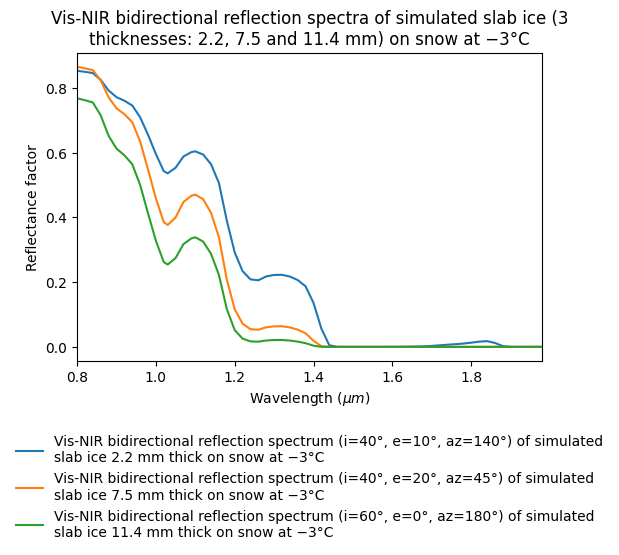- Title
- Vis-NIR bidirectional reflection spectra of simulated slab ice (3 thicknesses: 2.2, 7.5 and 11.4 mm) on snow at −3°C
- DOI
- 10.26302/SSHADE/EXPERIMENT_BS_20160912_001
- Data reference
- Andrieu, François; Douté, Sylvain; Schmidt, Frédéric; Schmitt, Bernard (2015): Vis-NIR bidirectional reflection spectra of simulated slab ice (3 thicknesses: 2.2, 7.5 and 11.4 mm) on snow at −3°C. SSHADE/GhoSST (OSUG Data Center). Dataset/Spectral Data. https://doi.org/10.26302/SSHADE/EXPERIMENT_BS_20160912_001
- Publications
- Database(s)
- Experimentalists
- Type(s)
- numerical modeling
- Description
- Vis-NIR bidirectional reflection spectrum of simulated slab ice (3 thicknesses: 2.2 mm [i=40°, e=10°, az=140°], 7.5 mm [i=40°, e=20°, az=45°] and 11.4 mm [i=60°, e=0°, az=180°]) on snow at −3°C
- Number of spectra
- 3
- Comments
- simulation
- Variable type(s)
-
- sample thickness
- Comments
- 3 slab ice thicknesses
- Laboratory
- Geosciences Paris-Saclay (GEOPS)
- Instrument
- Slab model - bidirectional reflection UV-NIR
- Standard medium
- vacuum
- Observation mode
- spectrum
- Spectral range type(s)
- Vis, NIR
- Valid spectral range(s)
-
Min - Max (${\mu}m$) Sampling (${\mu}m$) Resolution (${\mu}m$) Position accuracy (${\mu}m$) Absorption edge #1 0.8 - 1.98 0.02 0.02
Definition: incidence and emergence angles are positive with origin at nadir, and vary in same direction. Azimuth origin (increasing clockwise) is for i = e (opposition geometry).
- Observation geometry
- bidirectional
- Observation mode
- fixed angles
- Resolution illumination
- 0.0°
- Resolution observation
- 0.0°
- Observation mode
- single spot
- Parent experiment
- Vis-NIR spectral bidirectional reflection distribution fonction (SBRDF) of sintered snow (Arselle) and slab ice (3 thicknesses: 1.42, 7.45 and 12.5 mm) on snow at -10°C
- Date begin
- 2015-01-01
Versions
- Release date
- 2020-03-20 11:12:07+0000 UTC
- Version (Date)
- #1 (2020-03-20 11:12:07+0000 UTC, Updated: 2020-03-20 11:12:07+0000 UTC)
- Sponsors
-
- Programme National de Planétologie - INSU/CNRS (PNP)
- Centre National d'Etudes Spatiales (CNES) (OMEGA/Mars Express)
